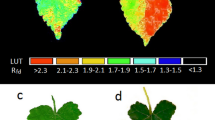Summary
In vivo chlorophyll fluorescence measurements have become a valuable tool in ecophysiology. Fluorescence emission spectra are influenced by the reabsorption of the tissue and indicate the composition of the antenna system and are influenced by the chlorophyll content per leaf area. The fluorescence induction kinetics (“Kautsky effect”) can be used to study photosynthetic activity. These rapid, non-destructive methods can be applied for ecophysiological field research to check the vitality of plants and to document stress effects on the photosynthetic apparatus. The Rfd-values (Rfd=fd/fs), the ratio of the fluorescence decrease (fd) to the steady state fluorescence (fs), can be taken as a rapid vitality index of the leaves and trees. We here describe fundamental chlorophyll fluorescence results of leaves which are needed for the interpretation of in vivo fluorescence signatures in stress physiology and in the forest dieback research.
Similar content being viewed by others
References
Buschmann C (1981) The characterization of the developing photosynthetic apparatus in greening barley leaves by means of (slow) fluorescence kinetic measurements. In: G Akoyunoglou (ed) Photosynthesis, Vol v, Balaban Intern Science Services, Philadelphia, pp 417–426
Kautsky H, Frank U (1943) Chlorophyllfluoreszenz und Kohlensäureassimilation. Biochem Z 315:139–232
Krause GH, Weis E (1984) Chlorophyll fluorescence as a tool in plant physiology. II. Interpretation of fluorescence signals. Photosynthesis Res 5:139–157
Lichtenthaler HK (1986) Chlorophylls and carotenoids, the pigments of the photosynthetic biomembranes. Methods in Enzymology (in press)
Lichtenthaler HK, Karunen P, Grumbach KH (1977) Determination of prenylquinones in green photosynthetically active moss and liver moss tissues. Physiol Plant 40:105–110
Lichtenthaler HK, Pfister K (1978) In: Praktikum der Photosynthese, Quelle & Meyer Verlag, Heidelberg
Lichtenthaler HK, Buschmann C, Döll M, Fietz HJ, Bach T, Kozel U, Meier D, Rahmsdorf U (1981) Photosynthetic activity chloroplasts ultrastructure and leaf characteristics of high-light and low-light plants and of sun and shade leaves. Photosynthesis Res 2:115–141
Lichtenthaler HK, Kuhn G, Prenzel U, Buschmann C, Meier D (1982) Adaptation of chloroplast ultrastructure and of chlorophyll protein levels to high-light and low-light growth conditions. Z Naturforsch 37c:464–475
Lichtenthaler HK, Schmuck G, Döll M, Buschmann C (1985) Untersuchungen über die Funktionsfähigkeit des Photosyntheseapparates bei Nadeln gesunder und geschädigter Koniferen. In: PEF-Bericht (KfK-PEF) 2 Kernforschungszentrum Karlsruhe, pp 81–105
Papageorgiou G (1975) Chlorophyll fluorescence: An intreinsic probe of photosynthesis. In: Bioenergetics of photosynthesis Govindjee (ed) Academic Press, New York, pp 319–371
Rock BN, Hoshizaki T, Lichtenthaler HK, Schmuck G (1986) Comparison of in situ spectral measurements of forest decline symptoms in Vermont (USA) and the Schwarzwald (FRG). In: Proceedings of the International Geoscience and Remote Sensing Symposium (IGARSS), Zürich 1986, ESA Scientific & Technical Publication branch, Nordwijk
Schmuck G, Lichtenthaler HK (1986) Application of laser-induced chlorophyll a fluorescence in the forest decline research. In: Proceedings of the International Geoscience and Remote Sensing Symposium (IGARSS), Zürich 1986, ESA Scientific & Technical Publication Branch, Nordwijk
Schreiber U (1983) Chlorophyll fluorescence yield changes as a tool in plant physiology. I. The measuring system. Photosynthesis Res 4:361–373
Schulze ED, Hall AE, Lange OL, Walz H (1982) A portable steady state porometer for measuring carbon dioxide and water vapeur exchange of leaves under natural conditions. Oecologia 53:141–145
Author information
Authors and Affiliations
Rights and permissions
About this article
Cite this article
Lichtenthaler, H.K., Buschmann, C., Rinderle, U. et al. Application of chlorophyll fluorescence in ecophysiology. Radiat Environ Biophys 25, 297–308 (1986). https://doi.org/10.1007/BF01214643
Received:
Accepted:
Issue Date:
DOI: https://doi.org/10.1007/BF01214643




